And God Said To Cain, Bandidos, Massacre Time, My Name Is Pecos (1966, 1967, 1970)
Directed by: Antonio Margheriti, Lucio Fulci, Massimo Dallamano, Maurizio Lucidi
Written by: Adriano Bolzoni, Antonio Margheriti, Enrico Maria Salerno, Fernando Di Leo, Giovan Battista Mussetto, Giovanni Addessi, Juan Cobos, Lucio Fulci, Romano Migliorini
Starring: Enrico Maria Salerno, Franco Nero, George Hilton, Klaus Kinski, Robert Woods, Terry Jenkins
VENGEANCE TRAILS: FOUR CLASSIC WESTERNS:
On Blu-ray 26TH JULY, from ARROW VIDEO

DISC ONE – MASSACRE TIME [1966]
AKA LE COLT CANTARONO LA MORTE FU….TEMP DI MASSACRO, THE COLT SANG DEATH AND IT WAS….MASSACRE TIME
RUNNING TIME: 83 mins
 Tom Corbett is prospecting for gold when he receives a message telling him to return to the family home in Laramie Town that his mother bequeathed to his estranged brother Jeff while sending Tom away. Upon arriving, Corbett is shocked to discover that the now dilapidated house, not to mention most of the town, is owned by land-grabber Mr Scott, whose psychopathic son Jason terrorises the locals, while Jeff has become a drunken wreck who lives in a run down shack with Native American wet nurse Mercedes….
Tom Corbett is prospecting for gold when he receives a message telling him to return to the family home in Laramie Town that his mother bequeathed to his estranged brother Jeff while sending Tom away. Upon arriving, Corbett is shocked to discover that the now dilapidated house, not to mention most of the town, is owned by land-grabber Mr Scott, whose psychopathic son Jason terrorises the locals, while Jeff has become a drunken wreck who lives in a run down shack with Native American wet nurse Mercedes….
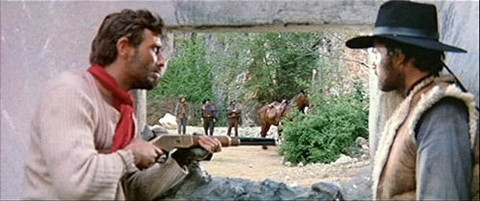
Though he’s generally known as a horror director, Lucio Fulci made many films in other genres in the first half of his career, and this is the first of his three westerns which show that he had a good feel for the genre. It contains some really impressive scenes and already shows Fulci’s interest in graphic violence, while also being helped by a good story line and very strong performances by newcomer George Hilton and Nino Castelnuovo. The feel is generally tough and gritty, with little of the familiar genre irony, but some comedy does surface, some of it involving Sonko, an oriental undertaker/blacksmith who spouts his own twists on Chinese-style sayings such as:”Confucius say: burying the dead is a gratuitous and pointless task, but Confucius – he dead, I live in this town not him”. The character works as light relief without unbalancing the serious nature of things, and it’s a real shame that he disappears. Also funny is our hero Jeff repeatedly proclaiming “excuse me gentlemen” in a friendly manner before opening fire on his opponents as if he’s trying to give them a fighting chance, and starting to drink from a bottle of whisky before throwing it away in horror because sambuca is his thing. Another thing I liked, being the un-PC type that I am, is the way that Jeff keeps on drinking throughout [to no objection from anybody] and ends the film as the alcoholic that he was at the beginning. Usually he’d have to be seen kicking his habit.
We open with what’s basically Fulci’s version of The Most Dangerous Game, with rich-looking men atop horses with a pack of braying dogs releasing a beaten man from a cage and giving him a small amount of time to get some distance away from them before giving chase. Eventually the dogs get him in a lake, obviously ripping him to bits with lots of blood on evidence even if we don’t see much detail, while the leader of the pack Jason Scott tilts his head and rolls his eyes back; he seems to be getting sexual satisfaction from the sight. The man’s blood washing downstream neatly takes us many miles away until we’re at another lake where Corbett is looking for gold, but soon has to leave for this typical town where he’s warned off. It’s unusual to have a Nero character not draw his gun for a while, not even doing anything when Jason guns down somebody for no good reason. Nero is as stoic as he usually was in his earlier roles, trying with limited success to channel Clint Eastwood, but he has a really cool black outfit in a very well costumed film. Hilton gives a fine comic performance as the permanently pissed Jeff, and looks like he’s doing everything too, which of course makes it more exciting when he’s leaning out of his saddle firing away, though the way that Jeff keeps on leaving his mate before then popping up to help him and in more than one case save his life is a bit daft, The big climactic gunfight is fast and athletic with silly but cool bits like Corbett firing at some opponents while in a wagon moving on its own when the wagon hits a wall and Tom is hurled into the air before cutting to him landing on his feet! It almost feels like you’re watching a John Woo film what with the way our heroes fall all over the place but are still able to shoot while doing so, the emptying of guns into a single person at close range, even some birds flying above.
The most striking sequence is Fulci’s first scene of prolonged brutality, where Tom and Jason duel with whips. Jason, due to not playing fair, quickly gets the upper hand and just won’t stop whipping Jason, with the impact of some of the lashes being shown, while all the time well-dressed, dandified onlookers watch with joy. Castelnuovo acts convincingly psychotic as Jason without over doing it; I like the way he often leans his head. I’m surprised that he didn’t become nearly as big a star as his The Umbrellas Of Cherbourg co-star Catherine Deneuve despite clearly being the better performer. There are several unusual family relationships in the film, the most interesting being that of Jason and his father. Dad has clearly spoilt and indulged his son to excess, which might be responsible for the latter having become such a monster. A scene where they both play the piano has a slight oedipal touch about it. As is sometimes the case, there’s little room for women; Mercedes the nurse has a few scenes, and there are just a couple of exchanges with prostitutes who work in the saloon. The final act is home to some revelations that are intended to surprise; I saw one of them coming, and we’re left with some details remaining rather sketchy, though all in all it works well as a tale. A few awkward edits both visual and aural suggest that the film was cut down. While more straightforwardly shot than some of Fulci’s successive films with lots of long takes of the performers, Fulci and cinematographer Riccardo Pallottini do like to have somebody’s head in closeup while others are in the distance, achieving a slight 3D effect. Aided by a suspenseful score by Lallo Gori with a terrific main theme of Ennio Morricone quality, Massacre Time is a minor western classic.
Rating: 









SPECIAL FEATURES
Alternate US dub
This excruciatingly poor sub is to be avoided. It was done in Italy for export release, but its terrible voicing was considered to be so poor that the US distributors American International Pictures put together one of their own which is really rather good as these things go, just like the dubs they did for some Godzilla films being far better than Toho’s dubs.
New commentary by authors and critics C. Courtney Joyner and Henry Parke
Two genre experts get together to give us a great track full of appreciation and insight, ranging from the filming style [loads of shots through windows!] to information about its fascinating director. We here that opinions differ as to whether Fulci wanted more violence or just shot the script [Fulci liked to tweak the truth if it maintained the image he liked to have of himself], have it observed that Castelnuco’s performance is similar to Oliver Reed’s in Paranoiac, and have it pointed out that Franco’s character not just tends to have characters come to him but is responsible for some of the bad stuff that happens. It’s surprising though that Joyner isn’t sure why Franco returned to Italy when he was on the verge of major stardom in the United States – unless the story that Franco tells about it on this disc and others could be porkies.
Two Men Alone – New documentary featuring a new video interview with actor Franco Nero and an archival video interview with actor George Hilton [49 mins]
Surprisingly lengthy, this inter-cuts a new interview with an older one [Hilton died two years ago], sometimes rather amusingly such as when Nero, who made three more films with this director, and Hilton have very different opinions of Fulci. Though it takes a while for them to start discussing the film, both men are good value, be it Hilton saying how he’d come home bruised and battered to his wife after shooting but still enjoyed the experience, or Nero saying that Sergio Leone told him that he wanted to make a film starring him, Eastwood and Terence Hill. If only. There’s a strange blip though when Camelot is being mentioned but we see the poster for Rio Bravo.
The Era of Violence – New video interview with film historian Fabio Melelli [18 mins]
Melelli takes us through the elements of the film including some memories by assistant camera operator Carlo Tafani whom he interviewed, as well as explaining what particular initials after some names on the credits of these films mean. Does he slightly overrate the film when he says it’s one of the most important spaghetti westerns? I’m not sure.
Italian trailer
DISC TWO – MY NAME IS PECOS [1966] AKA CUE ONCE DI PIOMBO, TWO OUNCES OF LEAD
RUNNING TIME: 83 mins
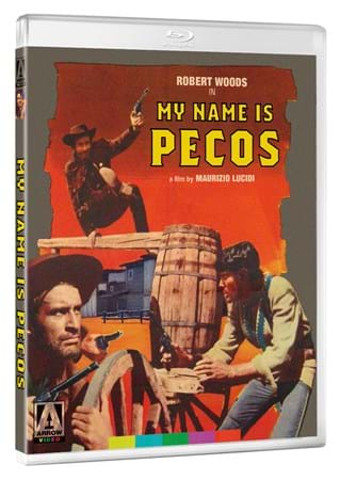 The small town of Houston has been taken over by the villainous Joe Kline and his gang of miscreants. Most of the town’s populace have left, and the unlucky few that are now trapped there include two brothers Eddie and Ned who run the saloon, their Mexican bar girl Nina, Dr Burton, his daughter Mary and a duplicitous pastor and undertaker called Morton. Kline and his men are searching for the proceeds of a bank robbery that a double-crossing former partner has hidden somewhere in the area. Then Pecos Martinez drifts into town, He appears to be a wanderer who’s just passing through, but actually he knows about the missing money and also has an old score to settle with Kline….
The small town of Houston has been taken over by the villainous Joe Kline and his gang of miscreants. Most of the town’s populace have left, and the unlucky few that are now trapped there include two brothers Eddie and Ned who run the saloon, their Mexican bar girl Nina, Dr Burton, his daughter Mary and a duplicitous pastor and undertaker called Morton. Kline and his men are searching for the proceeds of a bank robbery that a double-crossing former partner has hidden somewhere in the area. Then Pecos Martinez drifts into town, He appears to be a wanderer who’s just passing through, but actually he knows about the missing money and also has an old score to settle with Kline….
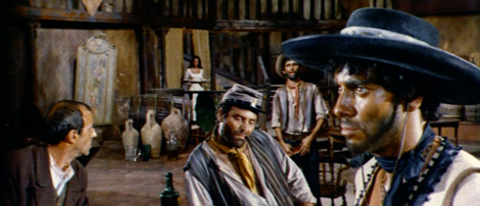
None of the remaining films in this set I’d seen before, but I had heard of My Name Is Pecos. It was a big hit in Hispanic territories because it featured a Mexican who for once was the hero on his own, instead of being paired with a gringo or, even more typically, being a villain. Pecos may not actually be played by a Mexican, but we’re continually reminded of his race. I can imagine Hispanic audiences cheering when Pecos enters the Houston[!] saloon and, despite being accosted and racially insulted by two bad guys, still demands tequila instead of whisky, before shooting dead the two bullies. When their bodies fall and rattle the floorboards, the needle arm on a record player falls into position and the Mexican folk song ‘la cucaracha’ starts playing. I almost cheered myself, it was such a cool scene. Nowhere near as stylish as Massacre Time and containing far less unusual touches, director Maurizio Lucidi’s simple, straight forward shoot em up still gets by with its very fast, action movie pace which doesn’t let more than ten minutes get by without somebody being threatened or killed, and has some rather interesting supporting characters even if its hero is your usual mysterious loner who much prefers to shoot rather than talk – though Robert Woods, a popular spaghetti western actor but not one I’d come across before, tries to add slight touches of vulnerability to the role which succeed despite being saddled with distracting makeup which thins his eyes yet doesn’t always work on one eye!
No time is wasted getting down to it with our hero stumbling across the desert and arriving at a house with a well where some villain is waiting for him. Pecos pays him twenty dollars in paper money for a revolver. As our hero walks away with his back to him, the villain replaces the gun that he sold to the stranger with another. “They call me Pecos” he says to the couple who live there before asking him to bury the dead man. It’s a nice introduction and is followed by a gun fight in the main street of Houston with our main bad guy Kline and his men engaged in a face off with somebody who’s just brought a barrel stuffed with money into the saloon. They kill him, then spend the rest of the film looking for the money, while Pecos spends the rest of the film sneaking in and out of the saloon where over half of the action takes place and killing bad guys who are usually beating up others or about to commit rape. He doesn’t seem to be aware of the irony of his doings making things worse for the other folk who are still living in the town, but most of them seem to like him anyway. He’s subjected to a very long beating partly shown via shadows which are projected onto the saloon’s opaque windows, but has no time for romance. We didn’t really need an early scene where he visits a grave where a four-person family has been buried, since it tells us everything we really need to know, but then screenwriter Adriano Bolzoni also shows us where the money is hidden quite quickly, so I guess he was going more for suspense over surprise.
Lucidi directs in a more classical style than was becoming the norm for the genre, but people still die with large bloody impact wounds while a small boy is shot dead right in front of our eyes. It’s easy to see why these films were popular even outside of Italy, with their higher violence quota making comparable American oaters seem tame and dull. Kline is an unusually restrained main villain while the few townsfolk remaining are quite well drawn, even if the three women are mostly there to be threatened [sexually and otherwise] or tortured. The two brothers Eddie and Ned are both very different; the former, who owns the saloon, also has a past association with Kline but we wonder if Pecos can trust him, while Eddie is naive and too good-natured for his own good. Dr Foster once had his hands when he failed to save the life of one of his injured gang members and is now a broken man. And then there’s Morton who, like A Fistful Of Dollar’s Silvanito, loves it when bodies fall because business booms for him [“everybody comes to see me eventually”], though he’s a much stranger character, a devious, money-grabbing schemer who twists the meanings of the scriptures to suit his own skewed worldview and tells the future on cards. Familiar Italian cult cinema face Umberto Raho gives a deliciously wicked and appropriately hammy performance as Morton. Massacre Time’s Lallo Gori’s score this time is just average; his main theme, sung over the credits, is basically ‘The House Of The Rising Sun’. With nary a dull moment, My Name Is Pecos rarely does much that’s different from the norm aside from its Mexican hero, but it has some verve.
Rating: 









SPECIAL FEATURES
New commentary by actor Robert Woods and C. Courtney Joyner
Arrow managed to get Woods to join Euro western expert Joyner for this commentary. Joyner has to keep on asking the questions but Woods is good company even though he talks more about his experiences regarding some other films too, such as refusing to do the sequel to Six Guns For MacGregor because the guy dubbing him was so poor, and working in the genre as a whole. He tells of how things were rarely set in stone; anyone on set could come up with an idea and if it was liked it was used, how he admired Jess Franco but stopped making films with him when Franco got into porn, and that he likes this film a lot. Joyner comments how a line in the English version could have been a very poor translation or deliberately tamer than the Italian version, but a quick comparison with the latter indicates that it’s in there too, at least going by the English subtitles. A genial, appreciative but always interesting commentary.
A Giant In The West – New interview with actor George Eastman [21 mins]
Eastman [real name Luigi Montefiore] seems to have a very good memory as he recalls working on the film and his whole spaghetti western phase with honesty – he’s not afraid to criticise things such as Pier Paolo Capponi always having the same expression on his face as Kline. We also hear of how Lucidi would assume a yoga pose for ten seconds to work out whether the left or right camera was rolling, how Eastman automatically made a noise when he fired his gun prop on his first movie role because it took him back to playing cowboy when he was a kid, and on how his height lost him roles.
Indecent Proposal – New interview with actress Lucia Modugno – [18 mins]
Modugno talks frankly and humorously about her movie career, including some not very flattering information about Lucidi who made her do a running scene six times and cut out most of her closeups because she turned him down. She also tells of how the toilets were gasoline tanks, and how she was elaborately tricked into doing a topless scene for another film. Modguno gives good value as an interviewee.
Pecos Kills – New documentary featuring a new interview with Fabio Melelli and an archival interview with cinematographer Franco Villa [19 mins]
Melelli discusses the film, including a crib from For A Few Dollars More which we’re also shown, and suggests that Villa is due for reappraisal, while Villa, in another old interview though you wouldn’t know it, tells of what it was like to work on movies like this, where he was often told that he’d get paid what he asked for on the next picture, and says that he likes watching them now though disliked the exaggerated sound.
DISC THREE – BANDIDOS
RUNNING TIME: 91 mins
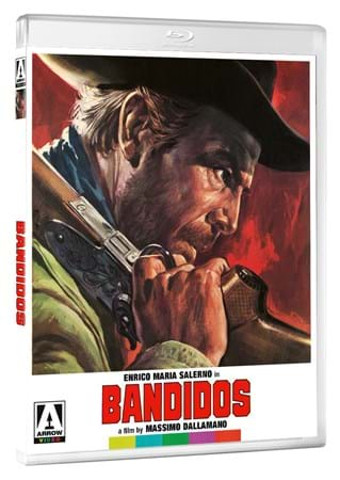
Renowned gunman Richard Martin is traveling on a train which is held up by murderous outlaw Billy Kane. Kane kills everyone except for Martin, though he shoots his hands so he can no longer use his gun. Years later, Martin is a broken man, just about getting by from hosting a gunslinger show which traveling from town to town, hosting a gunslinger show. When his latest demonstrator is shot, he meets an escaped convict who calls himself Ricky Shot, the name that Martin gives his demonstrators. Martin decides to take him under his wing, passing on his prowess with a gun, with the aim of using the young hotshot to gain his revenge on Kane. Could Mexican outlaw Vigonza, who Martin left at that train to take the blame, help too….

Bandidos isn’t as good as the first two films in this collection; it sometimes frustratingly suggests that its plot is going to be taken down very interesting pathways without delivering, and so many folks are shot that it doesn’t always seem necessary except that we obviously needed to have some deaths every few minutes. The two lead actors reminded me of Bud Spencer and Terence Hill with less humour and far less joint charisma, though individually the performances of both Enrico Maria Salerno [who dubbed Clint Eastwood for the Italian versions of the Dollars trilogy] and Terry Jenkins, despite neither being well known names, are fairly good. I only recognised Chris Huerta out of the performers, though that’s not necessarily a problem, and Bandidos is still decent western fun, from a director who became better known for his thrillers but who photographed A Fistful of Dollars and For a Few Dollars More before being got rid of by Sergio Leone despite him having contributed a lot to the style of those films. Massimo Dallamano is billed as Max Dillman here, though anglosising Italian credits in the hope that stupid American viewers wouldn’t know that they were watching an Italian film was quite common; for example Leone was initially billed as Bob Robertson. Dallamano gives us one especially impressive sequence early one where, after the train massacre, the camera very slowly pans along the train taking in all the dead bodies for a whole two minutes; the use of a song, called ‘Ballad of a Train’ in the titles, actually adds to the scene’s power. Violence is shown to have serious consequence throughout this film, though it still had amusing touches like the man who’s just lost a gunfight sitting at a table drinking and harassing customers and saloon girls while he waits to die from his bullet wound. This old woman tells him to “hurry up and die” and he decides he wants to shoot one of the saloon girls so that he can take her to hell with him.
There’s a brief preface saying that Bandidos has been slightly censored at the behest of the BBFC to remove two horse falls; the edits weren’t noticeable to my eyes, but it’s still truly ridiculous and pointless that we should still have such shots cut from movies made decades ago due to some archaic law. Anyway, we see a man being thrown off a train by a guard before the robbery takes place along with lots of killing, including of some of the men helping the main bad guy Kane, because it’s always best if there are as few witnesses as possible. Martin is supposed to be some gunfighter, but quickly has his weapon shot off him by Kane, who then puts two bullets into his hands. Some time later, Martin, now the owner of a traveling gun show, has his latest demonstrator shot, something which he’s used to, by somebody in the audience, and storms into the first of this film’s many saloons in anger, but isn’t too good even with just his fists. Fortunately another guy is at hand to help, and is soon roped into becoming the new Ricky Shot. Richard wants revenge, but ‘Shot’ might have an agenda too. Then there’s Vigonza who also wants to wreck vengeance on Kane, and Kramer who was Kane’s second in command but who ran out on him. Character motivations sometimes become a little confused and there are so many confrontations it almost becomes too much, but one of our leads gets a lady [albeit one of the night] to have some temporary fun with, and the stretched out final duel is hugely suspenseful as well as hinting at Dallamando’s thriller work, as does a stabbing carried out partly in shadow.
Dallamando supplies a few good conceits like us following a whisky bottle as it slides across the bar, and there’s some usage of Leone-like shots and staging though not all the time. The various bad guys are reasonably well characterised. One of them responds to an accusation of sleeping with a ten-year old girl getting the response “it wasn’t my fault, I thought she was twelve”. Venantino Venantini is a cold but unremarkable main villain. but Salerno gets a powerful scene where he has to slam his damaged hands against a wall in frustration; if only we’d had other moments like it so we could really feel Martin’s pain. There’s a nice idea in the form of a saloon which is divided into two halves, one for Mexicans and one for Americans, though more could have been done with it, as well as us being increasingly suspicious of Shot’s motives. Things seem to be getting really interesting before backing out, and the climactic revelations will only work if you avoid reading reviews of this film on the web; I looked because I wanted to clarify a few character names and was rather surprised. There’s some especially poor day for night filming and Egisto Macchi’s music score is mediocre; even his mariachi main theme is unmemorable. Bandidos is more a film of impressive moments rather than a fine hole, but that still means that it remains perfectly solid fare overall.
Rating: 









SPECIAL FEATURES
New commentary by author and critic Kat Ellinger
Ellinger begins her commentary by explaining why she’s talking about a western when she’s associated with other genres, though frankly she doesn’t have to; what’s wrong with liking and/or being knowledgeable about a very wide range of film types? I love all sorts of movies. She says that her main reason for doing it because she loves Dallamando’s work and feels that he’s highly underrated, and does spend a lot of time talking about him including teasing out themes in the work of a director who has no particular style, but does also show appreciation for what she wonderfully calls “a genre of glorious, ambiguous scumbags”, and wonders if Jenkins is the person of the same name who was Charles Laughton’s companion in his final years. Ellinger only goes into some of the other credits of some contributors near the end, and she does make a good case for Dallamando.
A Man in the Saloon – New interview with assistant director Luigi Perelli [18 mins]
Perelli says that Bandidos is “slightly let down by some of the performances” but then goes on to praise some of them”,talks about adapting sets, and compares the shooting style to that of Akira Kurosawa.
They Called Him Simon – New interview with actor Gino Barbacane [11 mins]
A really likeable old man who often laughs as he reminisces, Barbacane, usually billed as Simon Laffite, played heavies in all three of the above films and tells us that Fulci kept rushing people but was “a really nice guy” [that’s two who’ve said that now], recalls his gun on My Name Is Pecos going off and almost shooting him between the legs, and having to do a stunt falling down stairs several times while making Bandidos because Salerno kept making mistakes. Then he plays a tune on the accordion!
New interview with Fabio Melelli [11 mins]
Melelli tells us the locations, points out some classical western elements, and says how this film prefigures Dallamano’s later work. Some of his material tends to be on the commentaries too, but that can’t be helped.
DISC FOUR – AND GOD SAID TO CAIN [1970] AKA E DIO DISSA A CAINO
RUNNING TIME: 91 mins

Gary Hamilton has spent ten years in hard labour because of a crime he didn’t commit. An official comes along and tells him that he’s been pardoned. Hamilton immediately sets off for Torson City, bent on revenge. The richest man there is Acombar who’s now married to Hamilton’s ex-wife Maria and may have done Hamilton a great wrong, though his son Dick is unaware of this. Hamilton arrives in town at the same time as a tornado, and Acombar’s many men are waiting for him, but there could be some folk in the town on his side….
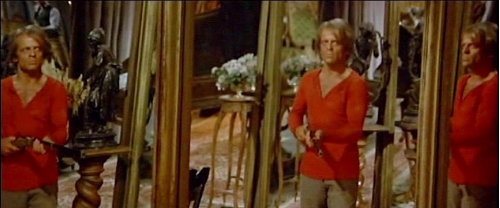
And God Said To Cain is rather different from all three of the proceeding films. Not knowing anything about it, I was pleasantly surprised that, after the first third, it turned into an example of a subgenre I like very much; the horror western, which has throw up works as diverse as Billy The Kid Meets Dracula, Grim Prairie Tales, The Burrowers and Shadow Of Chikara, not to mention High Plains Drifter which bares some similarity to this film though I think it was deliberate. Kat Ellinger spends much time in her commentary for Bandidos arguing the case for Massimo Dallamando as a so-called journeyman director who created work of substance, quality and skill but, judging by the films that I’ve seen [I certainly haven’t watched them all], I’d personally say that Antonio Margheriti [usually known as Anthony Dawson outside of Italy] deserves more reappraisal – okay, he was far more prolific so there are understandably some below par offerings, but there’s a distinct feel to his stuff and he was often able to work wonders with tiny budgets almost as well as Mario Bava, even if this is the only film in this set which employs the familiar frequent use of zooms of the period. I’d love to see Arrow release some of his wacky science fiction movies. Anyway, here we see Margheriti’s skill in creating a strong, dark atmosphere, which means that our attention doesn’t wonder despite the slow pace of this one in comparison to the others; the entire second two thirds are one lengthy set piece of our hero versus lots of bad guys, while the story is quite simple.
Rhe first third is more conventional, the opening shots of men similar to ones beginning some other spaghettis but the theme song we hear is unusually downbeat song and has elements of blues and gospel. Our hero – or should it be anti-hero – is played by Klaus Kinski who was in a lot of westerns but only played the lead in this one. He sometimes went over the top and sometimes sleepwalked, but is just right here despite us not being able to hear his real voice as usual; he’s mysterious, laconic and with an element of pain. “What did you say your name was”? asks the guy who he buys a gun off, a line repeated in High Plains Drifter, but after this whenever someone says his name windows open, curtains blow or birds squawk, while Hamilton appears at the same time as a tornado and appears and disappears quickly. He’s not a ghost, but clever usage of his environment and terrific skill instill fear as does the wind causing a sheet to trap people, and one can see why his opponents may think of the supernatural. However, we can’t see why someone thinks that locking him in a room will keep him there when he’s just got in through the window and can therefore surely leave by that way too. His main target is Acombar who has a son for whom he has high ambitions, but also a large number of lackeys. Hamilton dispatches them one by one, sometimes off screen, while surprisingly there’s little blood. Tension is kept high though, and while Dr. Jonathan and hooker Rosie whose husband was killed by Acombar are on Hamilton’s side, it seems like he doesn’t need them, especially when villains start killing each other.
Hamilton uses an underground system of caves that’s home to the most suspenseful scene, a quiet stalking bit.Sparse lighting, lots of fog and even a climactic fire, plus the interior design, are positively Gothic. A priest who believes “in a forgiving god” has a great extended death scene accompanied by his own organ playing, while Hamilton almost looks like death incarnate in his long Django-like black coat, though later on he loses it and runs around in a red shirt which is an odd choice. Margheriti and one of his two cinematographers Riccardo Pallotini or Luciano Trasatti have a lot of fun in the main room of Acombar’s house which is full of mirrors, beginning with Maria first getting up from her piano shown in five portions of the screen, and finishing with a full-on The Lady From Shanghai tribute or theft; aren’t the two often one and the same? Screenwriters Margheriti and Giovanni Addessi don’t tell us the details of why Hamilton is gunning for Acombar until near the end; they even have Hamilton explain it to Dick but we don’t hear it because the camera then cuts to the next scene. Peter Castern and Antonio Cantafora have some dramatic scenes together as father and son, and the final confrontation between Hamilton and Maria is quite dramatic though shies away from going as far as you think it’s going to, as do other elements; this is more a mood piece, and one entirely without humour except for an old man struggling to take mattresses into the saloon. Carlo Savina supplies a splendidly dramatic music score that helps keep things going when they might otherwise be on the verge of slacking. And God Said To Cain is conceptually simple but aesthetically very interesting,
Rating: 









New commentary by author and critic Howard Hughes
The only solo audio commentary in the set perhaps understandably has a few gaps and a lot of biographical material, especially seeing as there’s hardly any production information around about this film, though I’m not going to complain about details of Margheriti’s other work as I feel it needs more attention. We learn that this is actually a close remake of another film called A Stranger In Paso Brava, that previous home releases were so poor you often couldn’t see what was happening, and that Margheriti intended to follow this with a version of the Baron Munchausen stories also starring Kinski; why is it I think that would have been a perfect role for him? The track is oddly quiet though; I suggest you turn the sound up.
Between Gothic and Western – New documentary featuring a new interview with Fabio Melelli and a new audio interview with actress Marcella Michelangeli [20 mins]
This time Melelli, who clearly loves talking about these films, is inter-cut with another new interview instead of an old one, though it’s audio only. Melelli again adroitly describes the film’s flavour and qualities including similarities with Margheriti’s earlier Castle Of Blood, while Michelangeli, who played Maria, says how the slap she was given by Kinski was very real and had to be repeated several times, and that Kinski was, unsurprisingly,”a strange and violent person”.
New interview with actor Antonio Cantafora [12 mins]
Cantafora, who played Dick, says how he enjoyed working on this film despite Kinski being “hard to define” and his blonde look being “a bit annoying”. He’s the god father to Nastassja Kinski’s godchildren and mentions the strained relationship her and her father had; even though he says he doesn’t know all the details you can easily find out what may have happened elsewhere and it’s not pleasant reading – not that it may lessen your interest in this crazy but magnetic actor.
4-DISC LIMITED EDITION CONTENTS
High Definition Blu-ray™ (1080p) presentations of all four films
2K restorations of all four films from the original 35mm camera negatives, with ‘Massacre Time’, ‘My Name is Pecos’ and ‘Bandidos’ newly restored by Arrow Films for this release
This release showcases typically fine restorations; the occasional blemish, usually a vertical line, can be spotted which are obviously print damage. But colour and grain balance are excellent and the image is sharp.
Restored lossless mono Italian and English soundtracks
I mostly had the English tracks on for my watches though occasionally switched over to the Italian tracks which sometimes flow better but are no more authentic due to more cast members obviously speaking English. The English dubs are typical of their kind; decent if no more.
English subtitles for the Italian soundtracks
English subtitles for the deaf and hard of hearing for the English soundtracks
Galleries for all four films
Illustrated collector’s booklet featuring new writing by author and critic Howard Hughes
Fold-out double-sided poster featuring newly commissioned artwork by Gilles Vranckx
Limited edition packaging with reversible sleeves featuring original artwork and a slipcover featuring newly commissioned artwork by Gilles Vranckx
Illustrated collector’s booklet featuring new writing by author and critic Howard Hughes Fold-out double-sided poster featuring newly commissioned artwork by Gilles Vranckx
I really enjoyed all four of these films and they’ve been given terrific treatment by Arrow with all-new special features. This superb release comes Highly Recommended to all western fans even of the traditional American kind.


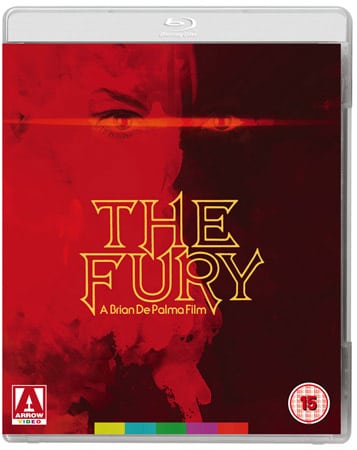


Be the first to comment